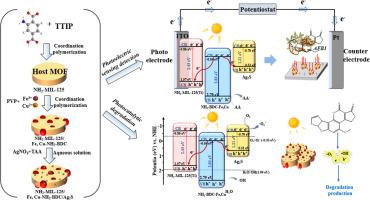Double Z-scheme MOF-on-MOF heterojunction for ultrasensitive photoelectrochemical biosensing and photocatalytic degradation of aflatoxin B1
IF 6.3
2区 材料科学
Q2 CHEMISTRY, PHYSICAL
引用次数: 0
Abstract
Developing dual-functional catalysts for simultaneous detection and degradation of carcinogenic aflatoxin B1 (AFB1) is crucial for global food and environmental safety. Herein, we demonstrate the rational design and synthesis of a bifunctional MOF-on-MOF-derived ternary heterostructure for ultrasensitive photoelectrochemical (PEC) biosensing and efficient photocatalytic degradation of AFB1. The MOF-on-MOF-derived ternary synergistic system was constructed via an epitaxial growth strategy, where NH2-BDC-Fe, Cu cores were initially anchored onto NH2−MIL-125 satellite surfaces, followed by in situ deposition of Ag2S nanoparticles onto the resulting Fe, Cu-MOF-on-Ti-MOF composite. Double Z-scheme heterojunction engineering substantially improves charge transfer rates while suppressing inherent electron-hole recombination in single MOF systems,providing critical support for performance optimization and application diversification. Furthermore, the multilayer nanoarchitecture intrinsic to MOF-on-MOF heterostructures orchestrates synergistic interfacial interactions that elevate photoelectrochemical (PEC) activity and drive enhanced photocatalytic degradation efficacy. When performing AFB1 analysis, the PEC biosensor incorporating this composite material and a specific aptamer demonstrates exceptional sensitivity, achieving an ultra-low detection limit of 0.29 fg/mL with a wide linear range spanning seven orders of magnitude (10−5 to 102 ng/mL). Furthermore, the NH2−MIL-125/NH2-BDC-Fe, Cu/Ag2S composite exhibits outstanding photocatalytic degradation efficiency and stability toward AFB1. Detailed investigations into the PEC sensing mechanism, photocatalytic degradation pathways, and primary degradation products were conducted. This work not only advances the fundamental understanding of heterojunction engineering but also provides a practical and promising solution for AFB1 contamination control, offering dual-functional capabilities for both detection and elimination in food safety applications.

双z型MOF-on-MOF异质结用于超灵敏光电电化学生物传感和光催化降解黄曲霉毒素B1
开发可同时检测和降解致癌物黄曲霉毒素B1 (AFB1)的双功能催化剂对全球食品和环境安全至关重要。在此,我们展示了合理的设计和合成双功能mof -on- mof衍生的三元异质结构,用于超灵敏光电化学(PEC)生物传感和有效的光催化降解AFB1。mof -on- mof衍生的三元协同体系通过外延生长策略构建,其中NH2- bdc -Fe, Cu核心最初锚定在NH2- MIL-125卫星表面,然后将Ag2S纳米颗粒原位沉积在得到的Fe, Cu- mof -on- ti - mof复合材料上。双z方案异质结工程大大提高了电荷转移速率,同时抑制了单MOF系统中固有的电子-空穴复合,为性能优化和应用多样化提供了关键支持。此外,MOF-on-MOF异质结构固有的多层纳米结构协调了协同界面相互作用,提高了光电化学(PEC)活性,并增强了光催化降解效率。在进行AFB1分析时,结合该复合材料和特定适体的PEC生物传感器表现出卓越的灵敏度,实现了0.29 fg/mL的超低检测限,线性范围宽,跨越7个数量级(10 - 5至102 ng/mL)。此外,NH2- MIL-125/NH2- bdc - fe, Cu/Ag2S复合材料对AFB1表现出优异的光催化降解效率和稳定性。对PEC的传感机理、光催化降解途径和初级降解产物进行了详细的研究。这项工作不仅促进了对异质结工程的基本理解,而且为AFB1污染控制提供了一种实用而有前途的解决方案,在食品安全应用中提供了检测和消除的双重功能。
本文章由计算机程序翻译,如有差异,请以英文原文为准。
求助全文
约1分钟内获得全文
求助全文
来源期刊

Surfaces and Interfaces
Chemistry-General Chemistry
CiteScore
8.50
自引率
6.50%
发文量
753
审稿时长
35 days
期刊介绍:
The aim of the journal is to provide a respectful outlet for ''sound science'' papers in all research areas on surfaces and interfaces. We define sound science papers as papers that describe new and well-executed research, but that do not necessarily provide brand new insights or are merely a description of research results.
Surfaces and Interfaces publishes research papers in all fields of surface science which may not always find the right home on first submission to our Elsevier sister journals (Applied Surface, Surface and Coatings Technology, Thin Solid Films)
 求助内容:
求助内容: 应助结果提醒方式:
应助结果提醒方式:


